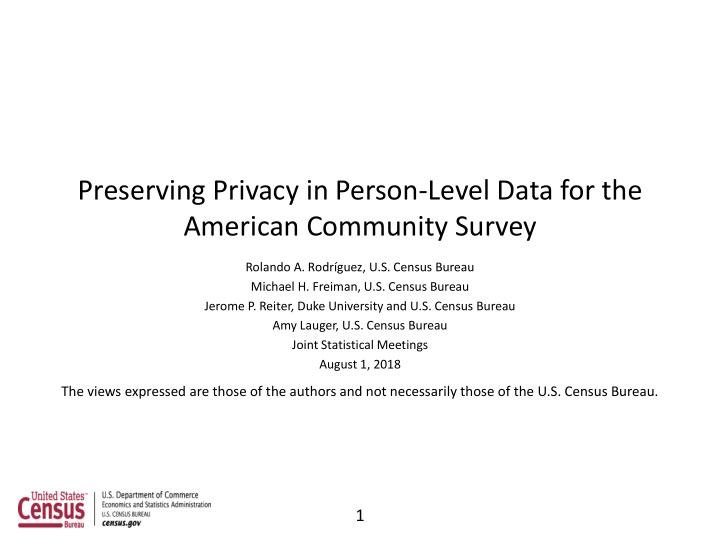



Preserving Privacy in Person-Level Data for the American Community Survey Rolando A. Rodríguez, U.S. Census Bureau Michael H. Freiman, U.S. Census Bureau Jerome P. Reiter, Duke University and U.S. Census Bureau Amy Lauger, U.S. Census Bureau Joint Statistical Meetings August 1, 2018 The views expressed are those of the authors and not necessarily those of the U.S. Census Bureau. 1
A roadmap for our research 1. Data protection goals for Census Bureau data • Protect data against all possible attacks • Quantify disclosure risk and data quality 2. Current methods do not fully achieve the goals 3. Differential privacy can achieve these goals • Assumed currently infeasible for American Community Survey (ACS) 4. Current synthesis research is intermediate step toward goals 2
The Census Bureau has multiple goals in protecting data In the current data environment, we must protect data against known attacks and attacks not yet known to us We need to quantify the risk and data quality that our disclosure methods allow Our methods should be transparent, so that users can account for the effect of disclosure on their inferences 3
Traditional disclosure methods will not be as effective in the future Currently, ACS protected with a variety of ad hoc approaches, with some parameters kept secret Current methods cannot be mathematically demonstrated to be safe Better database reconstruction algorithms and increased computing power will increase risk “Big data” means the Census Bureau can no longer assume it knows all of the data an attacker could use 4
Formal privacy provides the guarantees traditional methods lack A formal privacy framework, e.g., differential privacy, defines and quantifies the privacy loss from data releases Algorithms used to protect the data must be proven to limit the privacy loss to no more than a certain “budget” The Census Bureau is researching using formal privacy for more data products 5
The ROC curve shows the tradeoff in setting the privacy budget The choice of privacy budget is a tradeoff between data usefulness and privacy loss More privacy requires more perturbation More utility requires less privacy The appropriate point on the curve is a subjective decision 6
Making the ACS formally private is particularly challenging The ACS collects data from 2.3 million housing units per year and publishes 12 billion estimates annually, including 5-year estimates The ACS uses a complex sample weighting approach Some challenges are shared with the Census • Statistics are produced for small geographic areas • Some within-household relationships are important and should be reflected in the protected data We aim to make the ACS formally private in the future, but that is not our current focus 7
Model-based synthetic data will improve on current methods but will not be formally private We generate variables sequentially, not yet incorporating weights Each variable in the synthesis is created using the previously synthesized variables for that record We synthesize categorical variables with a classification tree • Grow a tree on the previous variables • Draw a value at random from the appropriate leaf 8
Current research analyzes the results of a synthesis Synthesis method: • We start with original values of sex, age, relationship to householder • We synthesize school enrollment, grade level attending, educational attainment Data source: 2014 ACS Public Use Microdata Sample unweighted data from Oregon We create 896 synthetic implicates and 4,480 bootstrap draws from the data 9
Education variables have properties that are useful to study School enrollment, grade level attending and educational attainment are useful to study because: • They have very close relationships with each other, particularly for those enrolled in school • They are approximately bounded depending on age • Values are often aggregated up to higher levels that are of more interest than the more detailed data 10
Tabular estimates look right on average For various tables, we made violin plots of the ratio of the value of each cell of the table based on the synthetic data and the original data Generally, average number of records in a cell across synthetic implicates was approximately correct Relative variance was larger for sparse cells 11
Violin plots of relative synthetic versus original estimates for cells in table of educational attainment – collapsed categories 12
Violin plots of relative synthetic versus original estimates for cells in table of educational attainment – detailed categories 13
Violin plots of relative synthetic versus original estimates for cells in table of educational attainment – detailed categories 14
Violin plots of relative synthetic versus original estimates for cells in table of educational attainment – detailed categories 15
Quality of data For each of several tables, we compute a measure of data 𝑀 1 quality: 1 − 2𝑂 , where 𝑀 1 is the L1 distance between the original table and the synthetic table and N is the sample size We compare the distribution of the metric for the synthetic implicates to the distribution for the bootstrap draws 16
L1 graphs show some synthetic data have quality comparable to the original data 17
We seek to improve how the model captures correlations between variables We have made progress in synthesizing variables, but we still want to improve our capturing of correlations between variables The tree method is designed to preserve the strongest relationships in the data, including non-linear relationships among more than two variables Some relationships of smaller magnitude may be important to preserve because of ways the data are used 18
The path forward presents unresolved challenges Test data synthesized so far reflect only some of the original data’s properties We need to incorporate weights into the final synthetic data We need to be able to synthesize data at levels lower than the state We need more metrics and benchmarks to assess suitability of various models We need to research the feasibility of formal privacy for this dataset Michael Freiman michael.freiman@census.gov 19
Recommend
More recommend